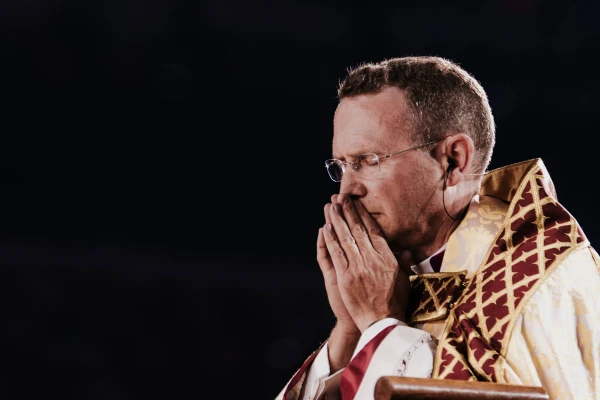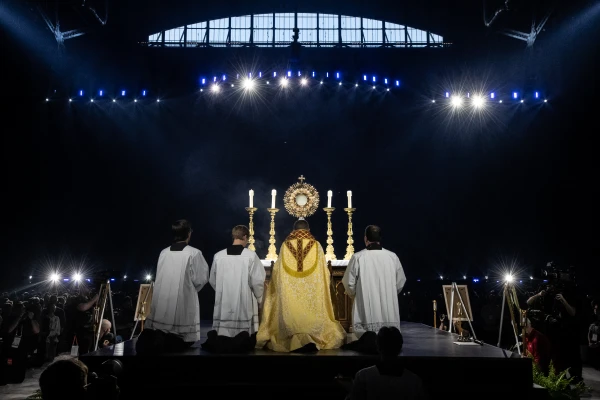CNA Staff, Jul 26, 2024 / 06:00 am
The 10th National Eucharistic Congress drew tens of thousands of people to Indianapolis last week seeking a rekindling of their faith in the Eucharist, the body and blood of Christ. Among the highlights of the five-day gathering were several massive sessions of Eucharistic adoration in Lucas Oil Stadium, a Eucharistic procession through downtown Indianapolis that attracted 60,000 people, and Mass with papal delegate Cardinal Luis Tagle, also held in the huge stadium.
The bishop who led the National Eucharistic Revival — Bishop Andrew Cozzens of Crookston, Minnesota — said the experience reminded him of Ephesians 3:20-21 in which St. Paul says God has the power to do more than “all that we ask or think.”
“God is able to do immeasurably more than you ask or imagine. And that was my experience,” Cozzens, who has spearheaded the revival since it was unveiled in 2021, told CNA.
“God showed us at this congress how good he is and how much he loves us, and that he’s not done yet.”

Excluding an International Eucharistic Congress that took place in Philadelphia in 1976, last week’s congress was the first such national event to be held on U.S. soil since 1941 — before World War II. The National Eucharistic Revival, of which the congress was a major part, is not finished — a special Year of Mission has now begun, which calls Catholics to share their rekindled love of the Eucharist with other people.
Cozzens said he has reflected on what makes a Catholic “congress” different from a “conference,” of which there are many each year. Although the congress featured some of the hallmarks of a conference like speakers, workshops, vendors, and exhibits, he said the main difference is that the congress had as its focus Jesus himself.
“The focus was on Jesus and the Eucharist and surrendering our hearts more to him and drawing close to him, and then also asking him to strengthen us for a mission,” he said.
Despite being well-prepared for the congress after years of planning, Cozzens said several things about the experience that surprised him — one of which was the impact the experience had on his fellow bishops, many of whom experienced great joy from seeing so many people turn out to worship and celebrate Christ. And on a personal level, Cozzens said he was surprised to see just how enormous a crowd of 50,000 people — 60,000 in the case of the Eucharistic procession — truly looked.
Standing high on the Indiana War Memorial at the endpoint of the procession, Cozzens blessed the multitudes who had come to follow Jesus.
“I was surprised by how powerful that was … I was sensing the Lord’s great desire to bless his Church and to bless the country,” Cozzens said of that moment.
“That’s what I was praying for during that benediction, for the Lord’s blessing to come down upon his Church and in our country in order to bless us and to draw us to himself. So I certainly was sensing that in those moments of prayer and the great privilege it is for us to be there.”
Several times throughout the congress, speakers and observers noted with excitement that there could well be “future saints” at the event. The 1976 International Eucharistic Congress in Philadelphia was attended by thousands of people as well as two future canonized saints — St. John Paul II and St. Teresa of Calcutta — and two other Catholics who are on the path to sainthood: Dorothy Day and Archbishop Fulton Sheen.
Observers also have compared last week’s congress to Denver’s 1993 World Youth Day, which directly led to a flourishing of Catholic apostolates in Denver and many vocations to the priesthood and religious life among attendees.
For his part, Cozzens said he hopes to see many vocations fostered by peoples’ experience at the congress. He told CNA that he witnessed a group of high school students from his own Crookston Diocese benefit from seeing so many priests and religious sisters.
Cozzens said he also heard about a seminarian who attended the congress who was considering leaving the seminary. The seminarian, after conversations at the congress about “the beauty of the priesthood and the joy of the priesthood,” decided to stay the course.
(Story continues below)
The congress included a night of prayer for healing during which Father Boniface Hicks, OSB, prayed a litany of healing prayers while the entire stadium kneeled before the Eucharist. Cozzens said he has heard from three victims of clerical sexual abuse — two of whom weren’t actually present at the congress but watched on television — who say they experienced profound spiritual healing in Jesus’ presence.
“Two of them said the same thing. They said, ‘For the first time in a long time, I can say I love being Catholic.’ So for someone who has been abused by a priest to be able to say that is really profound,” Cozzens said.

The next National Eucharistic Congress will take place in 2033, the “Year of Redemption” marking 2,000 years since Jesus’ crucifixion. Cozzens said he’s already been talking with other organizers about where the next host city should be — though there’s nothing official to share yet. Indianapolis received at least $60 million in tax revenue from the event, Cozzens said, so he hopes that whatever city the next congress lands in will be happy to welcome it.
Since prior to last week the most recent national congress was over 80 years ago, the Church in the U.S. had to rewrite the playbook for hosting an event like this, Cozzens noted. Though mostly smooth, organizers learned from the logistical challenges that emerged at the congress in an effort to make the next one better, such as how to mitigate hourslong lines for the Eucharistic Miracles exhibit and the Shroud of Turin exhibit.
“We’re going to continue to spend the next year really learning and praying and discerning about both what the Lord did and how we can assist that more,” he said.






